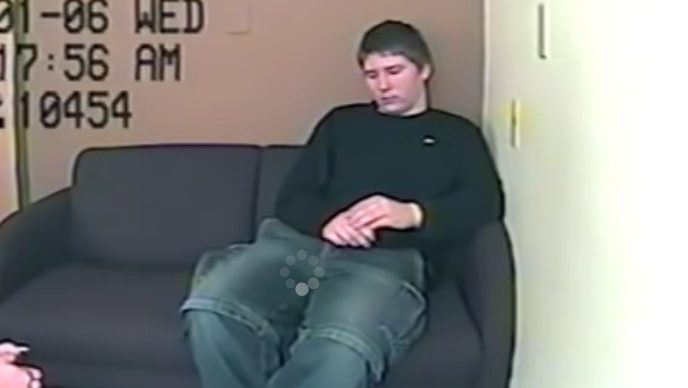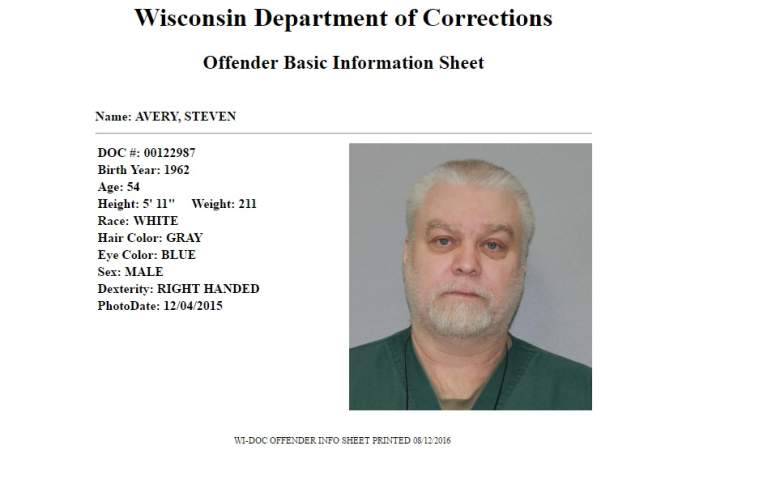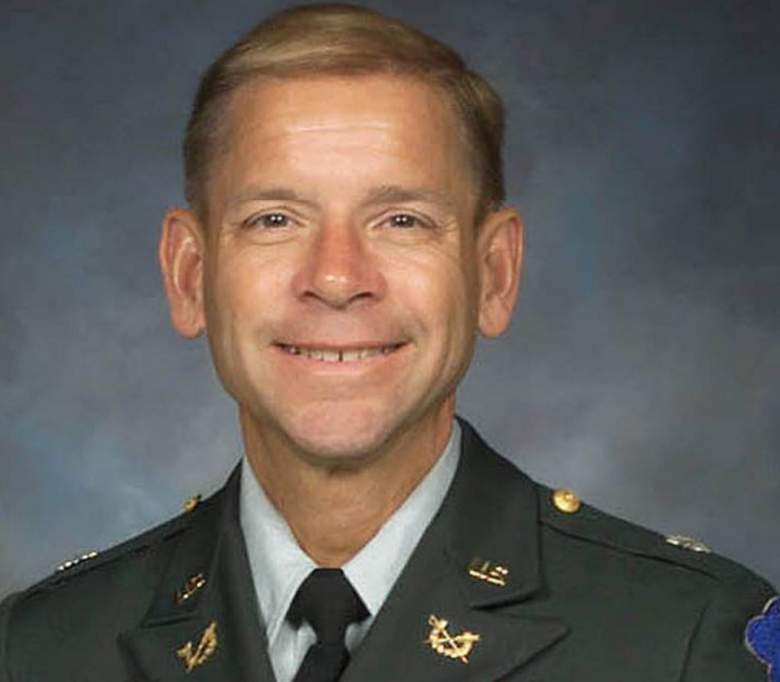
A screenshot from an interrogation of Brendan Dassey. YouTube
Now that a U.S. magistrate judge has overturned Brendan Dassey’s conviction in the murder of photographer Teresa Halbach, what happens next? Is a retrial likely?
Magistrate Judge William Duffin gave prosecutors 90 days to decide whether to retry Dassey or the judge says he must be released.
Prosecutors could decide to retry Dassey, now 26, but they would face enormous hurdles in doing so because the judge ruled Dassey’s confession was involuntary and that confession was the centerpiece of the state’s case against Dassey, who was 16 when Halbach was murdered (read a transcript here).
The State of Wisconsin could also appeal Duffin’s decision. If prosecutors decided to appeal and lost, the State would also then have to decide whether to retry Dassey absent the confession. If the state wins on appeal, there won’t be a retrial because the conviction would stand. Prosecutors have not yet said whether they plan to appeal or retry Dassey.
The Dassey case – and that of his uncle, Steven Avery – was prominently featured in Netflix’ Making a Murderer series, which sparked international outcry last winter.
There are major problems with a potential retrial, though, absent the confession.
The confession that Duffin found was involuntarily obtained formed the lynchpin of evidence in the state’s case. Thus, if prosecutors don’t succeed in getting Duffin’s ruling overturned (presuming they try), they would face the daunting prospect of going to trial with little else.
This stands in stark contrast to the case of Dassey’s uncle, Avery, who was also convicted in the murder of the 25-year-old photographer who had gone to the Avery family junkyard to take photos of a van for an auto trading magazine (Duffin’s ruling doesn’t apply to Avery, who was tried separately). Avery had previously been wrongfully convicted of sexual assault and spent 18 years in prison for that offense.
Avery was convicted in the Halbach murder case based on a web of forensic and circumstantial evidence, including blood and DNA evidence recounted in the court decision and that the defense unsuccessfully argued was planted. Dassey’s confessions were not used against Avery at trial; however, some in the jury pool did say they had heard about his confessions during questioning. Avery didn’t confess; he denied he did it. Thus, very different evidence was presented in the Avery case.
In Dassey’s case, no such forensic evidence was ever presented against Dassey. The confession was most, but not all, of the case.
Here is a review of the key pieces of evidence presented in Dassey’s case, according to the court decision and court records:
1. The ‘Confessions’
There’s no question: The March 1 videotaped confession that Dassey gave to interrogators formed the core of the state’s case. In elaborate (albeit, contradictory at times) statements, Dassey detailed witnessing and then participating in the crime.
However, Judge Duffin found that Dassey gave these statements involuntarily because the investigators made him false promises, because he didn’t understand the impact of his statements, because he was a cognitively slow 16-year-old, and because he didn’t have a lawyer or parent present.
Halbach disappeared in October 2005 after going to the Avery property to shoot photos of Dassey’s mother’s van for an auto trading magazine; at trial, prosecutors presented evidence that Avery called to ask for Halbach to come to the property.
A March 1, 2006 interview that Dassey gave to investigators was key at trial.
According to the court decision, Dassey, in this interview, told investigators Mark Wiegert and Tom Fassbender that he got off the school bus and saw Avery and Halbach talking on Avery’s porch and went home, cleaned his room, played videogames and ate dinner. Avery then called him requesting help with a car, he said in the interview, according to the court decision.

Steven Avery current Department of Corrections photo.
After persistent questioning, Dassey said Avery showed him a “knife and the rope” and eventually “came to say that he first encountered Halbach when Avery showed him her body, deceased, bound with rope, and wearing a black shirt, a ripped t-shirt and pants, in the back of her RAV4.” The victim’s RAV4 vehicle was found on the Avery property; state experts said both Avery’s and Halbach’s blood was in the vehicle.
After more questioning, Dassey said that “Avery told him that he had stabbed her and raped her because she had upset him,” the court decision recounts. After yet more questioning, he said, “that he and Avery took Halbach out of the back of the RAV4 and put her in the fire pit where a bonfire was already burning,” said the decision.
The interview continued, with Dassey eventually saying that he went inside Avery’s trailer and “could see down the hallway to Avery’s bedroom where Halbach was naked, handcuffed to Avery’s bed, and screaming for help.” After the investigators pressed him more, Dassey “eventually came to say he raped Halbach while Avery watched from the door way.” He then added more details: that Avery choked Halbach; that Dassey helped tie her up with rope; and that she was screaming for Avery to stop, the court decision says, while detailing promises the investigators made to Dassey.
Dassey drew pictures of things he had described during this interview, the court decision says. He also told investigators he helped move the car and he said that he later heard Avery had used a shovel to break up some of Teresa’s bones after the fire burned down, the decision says.

(Facebook/LenKachinsky)
That’s not the only time Dassey talked to law enforcement. Michael O’Kelly, a controversial private investigator hired by the defense, interviewed Dassey on May 12; Dassey’s then attorney, Len Kachinsky, had filed a motion to suppress the March statement but the trial court denied it. Dassey started by telling O’Kelly that he “did not really feel sorry because he did not do anything; he was only at the fire.”
“Eventually Dassey’s story changed and he recounted for O’Kelly a story largely similar to that which Dassey had told the investigators on March 1,” said the court decision.
The next day, Kachinsky arranged for the state’s investigators to interview Dassey again without his presence. This version of events “differed in certain significant respects from the version he recounted on March 1,” write the federal judge. “He denied seeing Halbach’s car, hearing any screaming, cutting her throat or seeing Avery punch Halbach.”
After investigators pressed him, Dassey said in this interview that the RAV4 was backed into Avery’s garage and that after Halbach was stabbed, Avery put her into the RAV4 before deciding to burn her, the decision says. The judge said the May 13 statement contained numerous internal contradictions.
“The centerpiece of the prosecution’s case was Dassey’s March 1 confession to (Investigators Mark) Wiegert and (Tom) Fassbender. The prosecution played the recorded interview for the jury at trial,” noted the judge. However, the May 13 interrogation was not discussed at trial. The judge was harshly critical of Kachinsky’s representation of Dassey, including allowing Dassey to be interviewed without his lawyer present.
The court decision also recounts in great detail statements investigators made to get Dassey to talk.
The judge found that the investigators’ “collective statements throughout the interrogation clearly led Dassey to believe that he would not be punished for telling them the incriminating details they professed to already know.”
“Especially when the investigators’ promises, assurances, and threats of negative consequences are assessed in conjunction with Dassey’s age, intellectual deficits, lack of experience in dealing with the police, the absence of a parent, and other relevant personal characteristics, the free will of a reasonable person in Dassey’s position would have been overborne,” wrote Duffin.
The graphic and detailed nature of the March 1 statement made it prosecutors’ core piece of evidence against Dassey; however, that’s the statement Judge Duffin says was involuntary (meaning it can’t be used).
2. No Forensic Evidence
This isn’t really “evidence presented.” It’s evidence not presented, but it needs underscoring. Crucially, prosecutors did not present any DNA, blood, fingerprint, or hair evidence against Dassey tying him to the Halbach murder, court records showed. They do not have forensic evidence to fall back on in a retrial, unless they come up with something new.
In contrast, the prosecution argued at Avery’s trial that investigators had found Avery’s blood in Halbach’s car; Halbach’s blood in her own car, which was found on the junkyard property; Avery’s DNA on Halbach’s car key, found in Avery’s bedroom; and Halbach’s DNA on a bullet found in Avery’s garage, the court decision and court records outlined. Defense attorneys argued this evidence was planted by law enforcement, which the state and law enforcement officers deny.
The defense had a lot of forensic evidence to explain away in the Avery case; in the case of Dassey, however, there was none.
In closing argument, Dassey’s new attorney (Kachinsky left the case) “highlighted the complete absence of any DNA evidence connecting Dassey to the crimes,” the court decision notes. “He also noted the absence of other evidence that he argued would have been found if the offense had occurred as Dassey said, such as Halbach’s blood not being found in Avery’s bedroom.”
3. Kayla Avery
Dassey’s young cousin went to a school counselor a few months after the Halbach murder and confided in the counselor that she was scared. The Milwaukee Journal Sentinel said Kayla “sought out a school counselor because she was scared about something her uncle, Steven Avery, had done.”
On Feb. 20, 2006, several months after the October murder, investigators interviewed Kayla, Steven Avery’s teenage niece, according to the court decision. The interview focused on Steven Avery but at the end of it, Kayla said her cousin, Brendan Dassey had been “acting up lately.” When asked to explain, Kayla said Dassey would stare into space and start crying uncontrollably and that he had recently lost 40 pounds, the court decision said (Dassey said he lost weight to impress a girl). See Kayla’s written statement here.
WMTV said Kayla “initially told investigators and others that Dassey told her he saw body parts in a bonfire at Steven Avery’s home the night Halbach disappeared.” The Associated Press says “Kayla Avery, 15, told her school counselor and then investigators that Dassey told her he saw body parts in a fire and saw Halbach tied up in a chair in Avery’s trailer.”
However, she denied that Dassey had told her anything like that when it came time for Dassey’s trial.
“A cousin of a teen accused of raping and killing a photographer cried on the stand Wednesday as she said she made up incriminating statements about him,” The Associated Press reported at the time of trial.
It’s unknown which version Kayla would give in a retrial but her past contradictions would pose a problem for prosecutors either way.
4. Bleach On His Pants
On February 27, Dassey told investigator Tom Fassbender in another interview that he “got bleach on his pants after helping Avery clean the floor of Avery’s garage on October 31.”
Investigators were able to corroborate this statement by obtaining the pants from Dassey and noting they had spots consistent with bleach on them. On March 1, 2006, Dassey gave the interrogators his bleach-stained jeans, the court decision says.
5. Dassey’s Own Statements on The Witness Stand at Trial
Dassey took the witness stand in his trial.
He denied murdering Halbach, but he did make some statements that might have influenced the jury.
In Dassey’s own testimony, as recounted in the court decision, he said he got off the school bus with his brother at about 3:45 p.m. the day of the murder, and played video games until he made himself dinner at about 5 p.m. His mother came home, and his brother and mother both left by 5:30, said the court decision.
He watched TV until 6 and received the call. He was watching TV until 7 when Avery called and invited Dassey over to the bonfire so he changed clothes. The bonfire is significant because burnt bone and teeth fragments consistent with Halbach were later found in the burn pit and barrel behind Avery’s trailer, along with camera and clothing bits.
Dassey testified that he went to the fire pit where Avery was burning branches and tires. They drove around in a golf cart picking up things to burn in the yard. Avery then asked Dassey to help him clean up something in the garage. “Dassey described it as looking like fluid from a car. They used gasoline, paint thinner and bleach,” said the court decision.
They then watched the fire, and Dassey went home around 10, he testified. He denied seeing Halbach that day. Asked why he told the investigators he participated in the rape and murder he said, “I don’t know,” the court decision says.
Dassey said on the witness stand that he had made up details in the March 1 confession and that he did not know why he had, the decision says. He said he might have gotten details from the book Kiss the Girls. He admitted lying to a detective earlier when he said during the week after Halbach was last seen that Avery did not have a fire. When asked why he lied, he said, “I’m just like my family. I don’t like cops,” said the court decision.
6. Presence On The Property Around When Halbach Disappeared
A witness reported seeing Dassey at the bonfire with Avery around 7:30 or 7:45 p.m. on the evening of Oct. 31, said the decision (The court decision says that Halbach had called the magazine where she worked around 2:30 p.m. that day to say she was on her way to the Avery property to photograph a van, and a witness saw her there around 2:30-2:45 p.m. She was never seen alive again).
During a Feb. 27 interview with investigators, Dassey “acknowledged being present at the October 31, 2005 bonfire with Avery and that he saw body parts in the fire,” the court decision said.
However, other people were also present on the property that day.
Dassey was dropped off by the school bus around 3:30-3:40 p.m., testimony said. Dassey’s brother testified that he was at home with Dassey until about 5:20 p.m. when he left, leaving Dassey home alone. Dassey’s brother’s boss also testified that he called the Dassey residence and spoke with Dassey that evening.
Dassey lived in a home on the junkyard property with his mother. Avery also lived on the property. Other people were also on the junkyard property that day.
7. Dassey’s Recorded Phone Calls to His Mother
The problem with one of these calls is that it was made at the urging of one of the investigators after one of the interrogations.
The calls were recorded by the jail. Dassey wanted to know what would happen if Avery’s story was different “like I never did nothin’ or somethin’.”
“Did you? Huh?” asked his mother, Barb Janda, the court decision recounts. “Not really,” said Dassey. “What do you mean not really?” Janda asked. “They got to my head,” said Dassey.
“Then Steven did do it!” Janda said at one point, according to the court decision, which describes Dassey as saying, “Ya.” Janda asks, “So in those statements you did all that to her too?” “Some of it,” Dassey responded, the court decision says.
He also said, “I went over there earlier and then came home before you did” and asked, “So if I was in the garage cleaning up that stuff on the floor, how much time will I get though for that?”
Janda asks, “What was it?” and Dassey replies, “I don’t know. It was this reddish black stuff,” the decision says.
“So did you see the body in the fire?” asked Janda, according to the decision. “No,” said Dassey. “You know if he killed her?” Dassey: “Not that I know of.”
When the recorded call was played at trial, Dassey said he had lied to his mother about going to Avery’s trailer before his mother came home that day. He said he did not know why he had lied to her, the decision says.


